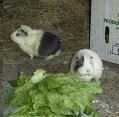|
 Home Home
 What's New? What's New?
 Definition Definition
 Our Design Our Design
 Techniques Techniques
 Articles Articles
 Blog Blog
 About Us About Us
 Year Planner Year Planner
 Resources Resources
 Links Links

Like us on
FaceBook!

Link to this site
|
|
Permaculture Techniques - Crop Rotation
Description
Plant groups are rotated in the garden or farm to avoid build up of pest and disease, and to avoid the depletion of nutrients in the soil necessary for plant growth. Plants which replenish nutrients to the soil are used, and rotation of plant groups is planned so that soil health is maintained or improved, with plantings benefiting successive plantings.
Benefits
- Regular pattern of crop production ensures the harvest, and rotation improves quality and yields.
- Method of pest control - no long term build up of pests specific to a particular crop.
- Disease avoidance, with emphasis on soil hygiene and healthy plants.
- Maintains nutrient balance in soil.
- Can help to control soil erosion, by keeping soil in suitable condition, building soil structure, and maintaining crop cover on soil.
- Better on site water management.
Procedure
- Research requirements and family groupings of selected plants.
- Prepare site thoroughly according to site, plant and other needs (slope, drainage, tilth, access, climate (rainfall, solar access, wind), microclimate, prevalent diseases, pests and weeds.
- It is possible to combine a no till system with crop rotation by sowing successive (grain) crops together, using fowl to weed growing crop and slashing green manure crop for mulching - information on this technique is available in the Permaculture Design Manual.
- Plan rotations (it may be wise, if not necessary, to keep detailed records of crop rotations), keeping in mind the following:
- never repeat one crop with another of the same sort or same family.
- don't follow root crops with other root crops.
- alternate heavy and light feeding crops.
- grow a nitrogen fixing crop in an area at least once a year.
- keep plants with the same water, mulch and nutrient needs together.
- make sure tall plants don't shade others unless shade is required.
- companion planting can still be used with care.
The following tables represent the layout and crop rotation schedule of our garden as it was originally devised. Over the years we have changed the garden - removed the typres, for example, and used recycled corrugated iron retaining walls instead - and this has meant that our original plan has fallen by the wayside. Many of the companion plants still grow in the vegetable garden and we loosely follow the same crop rotation plan.
|
|

Our ever-changing view!
Moonset ~ Roll Cloud ~ Sunset
|
permaculture ethics |
care for earth,
care for people,
return surplus,
reduce consumption |
 |
|
Recently Added Pages
Hot Links!

Bookworm is currently reading...
This site is sponsored by
ALWAYS LEARNING BOOKS
Publishers of Australian
books on Home Education.
  The Educating Parent The Educating Parent
  Beverley's other websites Beverley's other websites
|





